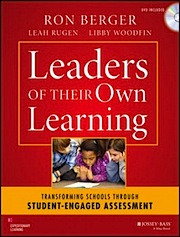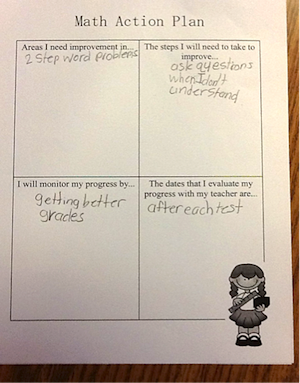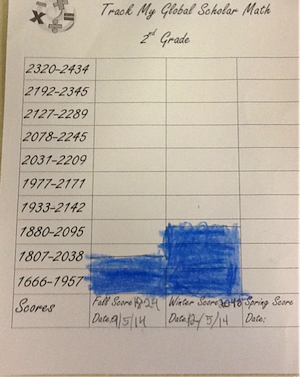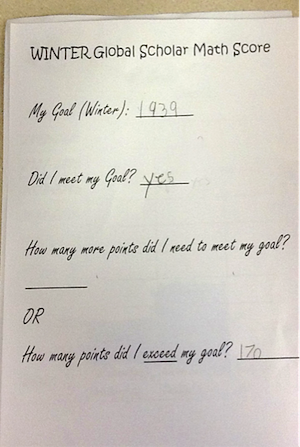Amy Donnelly is the Instructional Coach for Weeden Elementary School in Florence, Alabama. (This post originally appeared in December 2014.)
I became interested in data notebooks after I read Ron Berger’s Leaders of Their Own Learning (2014). I had worked with the teachers in our school to look at, analyze, and formulate goals for their classroom data but realized (thanks to Berger) that we’d left out a very important element in this process – our students.
 Our teachers and school leaders held the learning secrets but we were not sharing them with our learners the way we should. This had to change!
Our teachers and school leaders held the learning secrets but we were not sharing them with our learners the way we should. This had to change!
The formative assessment process described in Advancing Formative Assessment in Every Classroom (Moss and Brookhart, 2009) poses three core questions: Where am I going? Where am I now? What strategy or strategies will help me get to where I need to go?
These were critical questions that our students needed to consider and integrate into their learning. Could data notebooks help us provide the answers to these questions?
The notebooks might also provide the interest and motivation that we were often lacking. Children are fascinated by themselves, so wouldn’t a book all about them and their learning motivate and excite them? I wanted to see.
Introducing the notebook idea
During a data meeting at school, we discussed the potential benefits of using data notebooks with the teachers: motivation, engagement, and ownership of learning. I offered to purchase all of the materials that would be needed to make the notebooks, gather the resources needed, put the notebooks together and work with the students to explore and craft their initial data entries.
After the meeting, a third grade teacher said she was also interested in data notebooks and would be willing to try them in her classroom. We set a date and began to plan.
Developing the notebooks
One of the first things I needed to find was an example of a data notebook that the teacher liked. I found a clever design on Teachers Pay Teachers that helped us get started. We used pieces from the example and created other pieces tailored to our particular needs. We included personal goals, data graphs, academic goals and reports from GlobalScholar.
The teacher listed two or three standards-specific academic goals in math and reading for each student and put them on an index card. The goals were obtained from standards that the students had not mastered on their previous benchmark tests. The students were allowed to choose the standards for their goals. (right: Weeden 3rd grade teachers)
As I worked with the students, I had to make several adjustments. One of the pieces that we included concerned how the students planned to accomplish their goals. This was a difficult question for 3rd graders and they struggled with it, not really understanding how to answer. I created a paper for them with several choices to choose from. A few of examples included: I can check my work, I can listen to instructions, I can ask question when I don’t understand, etc…
We also created some examples of how they might decide that their goals had been accomplished. If a student needed help I shared these choices with them when they were setting their goals, and most of them knew exactly which one they needed to choose.
The students and I also studied their Global Scholar report in depth. Global was an area that teachers used for data, but students had not received much feedback about their tests. I discussed with them what the reports meant and how to read them.
We talked about why their scores were lower at the beginning (the test included standards for the entire school year and they were tested at the beginning of the year). We also discussed why they were supposed to show a half of a year’s growth at mid-year (more of the content had been taught).
We graphed their scores by quartile and wrote their gains goals for the next test administration. When they took their Winter Benchmark test, they wrote down their new scores and determined if they had met or exceed their goals.
All of the goals in the notebooks have a timeframe for the students to accomplish them. The students evaluate their goals periodically. If a goal has been mastered, the student sets a new goal based on current data. If a goal has not been mastered, then the plan is redone and the student continues to work toward mastery of the goal.
Students like knowing about the what & why
Currently one-third of the classrooms in our school have implemented, or are waiting to implement, data notebooks this school year.
Data notebooks have provided our students with specific, individual information about their academic strengths and weaknesses. The teachers who have begun using the notebooks say their students are more interested in their learning and understand more about what they are doing and why.
https://www.youtube.com/watch?v=nTU_4lfKwMI
Video: Students at Weeden Elementary review their data notebooks (Alabama GRIT, 2016)
The students that I have worked with often mention that they have met their goal or have shown growth. They are excited about their growth, and it is our hope that this excitement will continue to be fostered through the use of their data notebooks.
Amy Donnelly, a teacher/leader for 21 years, is the instructional coach at Weeden Elementary (PK-4) in Florence, Alabama. She is a member of the Alabama Instructional Partners Network.






0 Comments on "Using Data Notebooks for Student-Engaged Assessment"